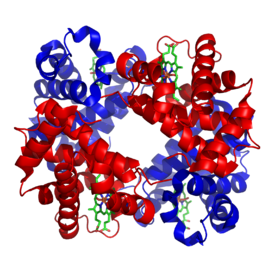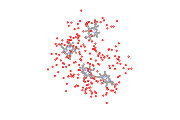Haemoglobin
Click for a 3D view of Haemoglobin. Very large files, consider using Google Chrome on a fast computer.
 Hemoglobin (also rendered as haemoglobin and abbreviated Hb or Hgb) is the iron-containing
oxygen-transport metalloprotein in the red blood cells of all vertebrates, with the exception
of the fish family Channichthyidae, as well as the tissues of some invertebrates. Hemoglobin
in the blood carries oxygen from the respiratory organs (lungs or gills) to the rest of the body
(i.e. the tissues) where it releases the oxygen to burn nutrients to provide energy to power
the functions of the organism, and collects the resultant carbon dioxide to bring it back to
the respiratory organs to be dispensed from the organism.
Hemoglobin (also rendered as haemoglobin and abbreviated Hb or Hgb) is the iron-containing
oxygen-transport metalloprotein in the red blood cells of all vertebrates, with the exception
of the fish family Channichthyidae, as well as the tissues of some invertebrates. Hemoglobin
in the blood carries oxygen from the respiratory organs (lungs or gills) to the rest of the body
(i.e. the tissues) where it releases the oxygen to burn nutrients to provide energy to power
the functions of the organism, and collects the resultant carbon dioxide to bring it back to
the respiratory organs to be dispensed from the organism.
Hemoglobin consists mostly of protein (the "globin" chains) subunits, and these proteins, in turn, are folded chains of a large number of different amino acids called polypeptides. The amino acid sequence of any polypeptide created by a cell, is in turn determined by the stretches of DNA called genes. In all proteins, it is the amino acid sequence, which determines the protein's chemical properties and function.




